
HOW TO PLAY BACCARAT
THE BASIC RULES WHEN PLAYING BACCARAT:
- After all bets are made at the Baccarat table, two hands are dealt consisting of two cards to each hand (known as the player hand and the Bank Hand)
- The objective is to guess which hand will have a total closest to 9
- Players can wager on the Bank Hand, player hand, or on the tie bet
- Face cards and tens have a count of zero, and aces count as one. All other cards count their face value
- If the count of a hand exceeds 9, the total is adjusted by subtracting 10.
- There are house rules that determine whether the bank or player hand receives a third draw card. (there is a maximum of three cards per hand.)
- Players who wager on a winning player hand receive a 1 to1 payoff
- Players who wager on a winning Bank Hand also receive a 1 to 1 payoff but must pay a 5% commission (including the 5% commission, the payoff odds are 19 to 20.)
- The payoff odds for a winning tie bet are 8 to1
Most everyone remembers the famous image of secret agent James Bond playing the casino game of Baccarat (pronounced bah-cah-rah) in the popular James Bond novels and movies. Although the game appears serious and elegant (and intimidating to average players), it’s actually as simple to play as betting on a flip of a coin; and, get this, the house edge is one of the lowest in the casino.
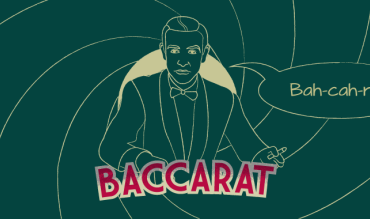
The casino game of Baccarat is based on the Italian game of baccara. The Italian word “baccara” simply means zero, and the latter refers to the fact that in baccarat, all the picture cards and tens have a value of zero.
Baccarat was first played in the 1400s in Italy and France. During the reign of King Louis XIV (1643-1715), Baccarat was one of the most popular games played by French royalty. Even though public gambling became illegal in France (in 1837), Baccarat continued to be played in the homes by the elite and common folks. This kept the game thriving for many years until it appeared again in casinos that sprang up on the Riviera (circa. 19th century). It eventually became the premier game in European casinos.
Over the years, there have been several versions of the game:
- American Baccarat (also known as punto banco)
- Chemin de fer (also known as Chemmy)
- Baccarat Banque
The above versions of Baccarat have virtually the same rules; the major difference is how the cards are dealt. (I’ll explain the details of each game in Chapter 2.)
Punto Banco made its debut in Las Vegas on November 20, 1959, thanks to professional gambler Tommy Renzoni, who convinced the management at the Sands casino to try it. Renzoni had previously introduced the game at the Capri casino in Cuba, saw how popular it was, and after he made a few modifications to the game, knew it would be a big hit in Las Vegas. He was right; after the Sands started offering Punto Banco, more casinos began offering it on the Strip and downtown casinos, more players were playing it, and the game’s popularity took off.
Many American players feel intimidated by Baccarat, mistakenly believing it’s a game played by high rollers wearing formal attire in a separate part of a casino (known as the high-limit pit). That’s unfortunate because there is a low-stakes version of the game (Mini-Baccarat) that is usually played in the main casino on a blackjack-sized table. (See below for details on mini- and Midi-Baccarat tables.)
ADVANTAGES OF PLAYING BACCARAT
Why play Baccarat? The game has these advantages:
- Playing rules are easy to learn
- Game offers even an inexperienced player one of the best odds in a casino
- No matter your betting level, you can usually find high- and low-stakes versions of the game in a casino
- Baccarat is also available in online casinos
OBJECTIVE OF BACCARAT
Regardless of the number of players, only two hands are dealt in Baccarat: the Bank Hand and the Player Hand. Before the cards are dealt, you place a wager with chips (also called checks) on which hand will come closest to a total of nine. You can wager either on:
- The Bank Hand
- The Player Hand
- A tie (meaning, both hands will have the same total)
(Note: You could wager on any combination of the above if you wanted to, such as a bet on the Bank Hand and another bet on the Tie.)
BACCARAT PAYOUTS
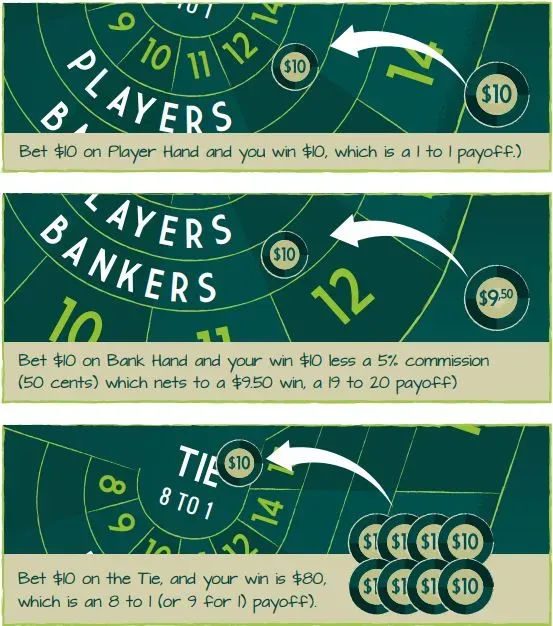 PLAYER HAND
PLAYER HAND
A winning bet on the Player Hand is paid at 1 to 1. For example, if you bet $10 on the Player Hand and it wins, you would receive $10 in winnings.
BANK HAND
A winning bet on the Bank Hand is paid at 1 to 1 minus a 5% commission on the winning bet. This is equivalent to a 19 to 20 payoff, meaning if you wager $10, you would win $9.50. (The reason you pay a commission on only the Bank Hand will be discussed shortly.)
A TIE
A winning bet on the Tie is usually paid at 8 to1, meaning if you win, you receive 8 winning chips and you get to retain the original 1 chip wagered on the Tie. For example, if you wager $10 on the Tie and it wins, you would receive $80 in winnings and retain the original $10 wager. If there is a tie, a bet on the Bank or Player Hand is a push, meaning neither hand wins or loses. After a tie, you can remove or add chips to either wager, switch wagers, or just remove your chips and not bet.
(Note: Some casinos state a 9 for 1 payoff for a winning bet on the Tie. This means they pay you 9 chips but keep the original 1 chip you wagered. A 9 for 1 payoff is equivalent to an 8 to1 payoff.).
BACCARAT CARD VALUES
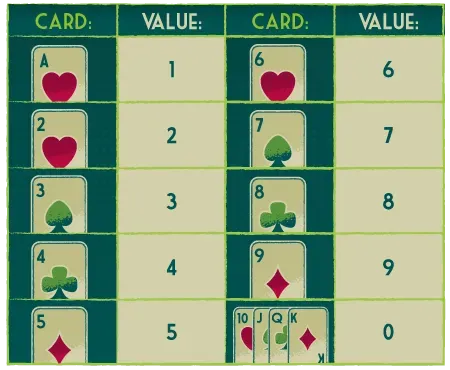 Baccarat is usually played with mostly eight decks of cards (and sometimes six decks) that are dealt from a dealing shoe. Every card has a numerical value (see table on the right), and card suits have no relevance in Baccarat.
Baccarat is usually played with mostly eight decks of cards (and sometimes six decks) that are dealt from a dealing shoe. Every card has a numerical value (see table on the right), and card suits have no relevance in Baccarat.
The values of the cards are as follows:
- Tens and picture cards (Jack, Queen, and King) have a numerical value of 0
- Aces have a numerical value of 1
- 2s through 9s have a numerical value equal to their face value.
The highest total a hand can have in Baccarat is 9. (A hand can’t “bust” if it totals greater than nine.) If the numerical value of the cards in a hand exceeds a total of 9, then you can do either of the following to arrive at the adjusted total of the hand:
- Drop the first digit of the sum
- Subtract 10 from the total
Here are some hands and their adjusted totals:

In the first hand, the sum of the value of the cards is 15. Since a hand in Baccarat can’t exceed a total of 9, either drop the first digit (the 1 in 15) or subtract 10 (15 minus 10) to get the adjusted total of 5. (Either way you do it is up to you; just be consistent.)
The second hand above totals 14 (8 + 6 = 14). If you drop the first digit, or subtract 10, you arrive at the adjusted total of 4.
DIFFERENT SIZE BACCARAT TABLES
There are three sizes of Baccarat tables:
- Full-size Punto Banco Baccarat
- Mini-Baccarat
- Midi-Baccarat
The rules for playing are the same; the differences are the number of players, how the cards are dealt, and the minimum and maximum betting limits.
FULL-SIZE PUNTO BANCO
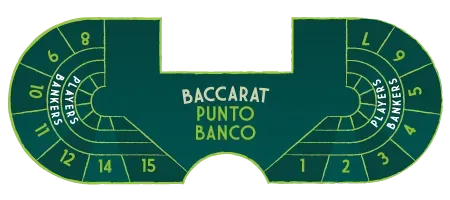 Also known as Big Baccarat, the full-size Baccarat table is located in a high-limit pit (or sometimes in a Baccarat room). The tables can accommodate up to 14 players, and the betting limits are often the highest in the casino (e.g., in casinos on the Las Vegas Strip, the betting range is usually $100 minimum bets up to $100,000 maximum bets). Players traditionally handle the cards; the biggest bettor on the Bank Hand gets to turn over the Bank cards, and the biggest bettor on the Player Hand turns up the Player cards. Three dealers staff the table. Big Baccarat caters to high-end players (i.e., high rollers or whales), who sometimes wager thousands of dollars on each hand. Casinos also tolerate these players when they occasionally bend, crumble, crush, and even tear in half the cards in the process of peeking at them before turning them up. (Because of this, fresh decks of cards are introduced into play before each shuffle.)
Also known as Big Baccarat, the full-size Baccarat table is located in a high-limit pit (or sometimes in a Baccarat room). The tables can accommodate up to 14 players, and the betting limits are often the highest in the casino (e.g., in casinos on the Las Vegas Strip, the betting range is usually $100 minimum bets up to $100,000 maximum bets). Players traditionally handle the cards; the biggest bettor on the Bank Hand gets to turn over the Bank cards, and the biggest bettor on the Player Hand turns up the Player cards. Three dealers staff the table. Big Baccarat caters to high-end players (i.e., high rollers or whales), who sometimes wager thousands of dollars on each hand. Casinos also tolerate these players when they occasionally bend, crumble, crush, and even tear in half the cards in the process of peeking at them before turning them up. (Because of this, fresh decks of cards are introduced into play before each shuffle.)
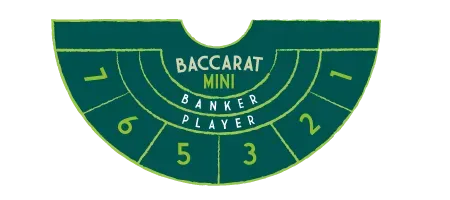 MINI-BACCARAT
MINI-BACCARAT
Mini-Baccarat is a low-stakes version of the big Baccarat game. Mini-Baccarat tables are located in the main casino next to the blackjack tables, and they can accommodate up to 6 or 7 players. Minimum betting limits are usually $5 to $15, with a maximum betting limit of up to $5,000. The table has only one dealer, and unlike the big Baccarat table, players are not allowed to handle the cards (the dealer deals the cards). Because of the latter rule, the game is much faster than the big Baccarat version (over 200 hands dealt per hour vs 40-70 for big Baccarat).
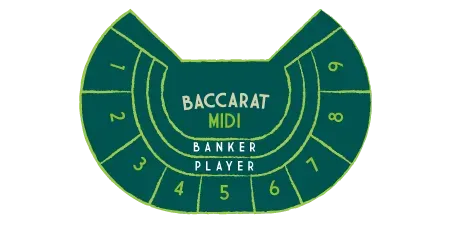 MIDI-BACCARAT
MIDI-BACCARAT
Midi-Baccarat tables have seats for up to 9 players and are staffed by one dealer. Since players like to handle the cards, Midi-Baccarat was designed to allow this. (However, casinos don’t tolerate players bending or crushing the cards.) The game can be found in either the high-limit room or in the main casino. Midi-Baccarat isn’t as fast as Mini-Baccarat but casinos can usually deal more hands per hour than the big Baccarat game. The betting limits are lower than the latter but higher than Mini-Baccarat tables (e.g., $25 up to $10,000).
MECHANICS OF PLAYING
By way of an example, I’ve summarized below how the cards are dealt on the Big Baccarat table (also known as the full-size table).
After the dealer shuffles a fresh pack of eight decks of cards, she will ask one of the seated players to insert the cut card somewhere into the stack of eight decks. (By doing this, the casino is allowing the customer to establish the starting point for the dealing of the cards.) The dealer will cut the cards so that the card following the placement of the cut card by the customer is at the top of the stack of cards (and will be the first card dealt from the shoe). The dealer then counts 15 cards, beginning with the last card in the stack of cards, and inserts a cut card. (When this cut card appears in play, the round in progress is completed and then the game is paused while a fresh set of eight decks is put into play and shuffled.) The eight shuffled decks are then placed into the dealing shoe and the dealer will remove the first card and turn it over. The face value of the card determines how many additional cards are “burned” or removed from the shoe. For example, if the first card was a six, then the next six cards are removed from the shoe and burned. If the first card was a ten, then ten cards are burned. All the burned cards (and subsequent discards) are dropped by the dealer into a discard bowl located under the table through a slot located in the middle of the table.
A full-size Baccarat table has room for up to 14 players. The table layout (see below) has each seat numbered from #1 through #15. (Usually, the unlucky number 13 is not displayed on a Baccarat layout; likewise, the number 4 is often not displayed because in some Asian cultures, the number 4 represents death.) In front of each player there is an area (or box) on the layout for placing your chips on the Player Hand, Bank Hand, or the Tie. (See diagram below.)

Three casino dealers direct the game. One dealer (the Caller) is positioned in the middle of the table (where the cards for the Player and Bank Hands will be placed). The Caller’s job is to direct the flow of the game and call the winning hand. The other two dealers are positioned next to each other and located opposite the Caller. Their task is to collect the losing bets and pay off winning bets from players seated on their half of the table, and they also keep track of all the commissions owed by players on winning Bank Hand bets.
Traditionally, players had the chance to deal the cards on the full-size Baccarat table; however, nowadays the Caller will deal the cards from a shoe and then give the cards to the player using a device known as a paddle. The initial two Player Hand cards are given to the player who made the largest wager on the Player Hand. This player looks at the two cards and then tosses them to the Caller, who places the cards on the layout labeled PLAYERS and then announces the total of the hand (e.g., Player shows 6). This procedure is repeated with the Bank Hand, with the player with the largest wager on the Bank Hand getting to look at the two cards before tossing them to the Caller, who announces the total of the Bank Hand (e.g., Bank has 3). If one or both hands require a third card, the Caller will give the draw card to the same player (via the paddle) to look at and then toss back to the Caller. The Caller will announce the winner (e.g., Bank Hand wins 7 over 5). The dealers will then collect the losing bets, pay off the winning bets at even money (except the Tie bet, which wins 8 to1), and in the case of a winning Bank Hand, place a marker indicating the 5% commission owed into the players’ commission boxes (located in front of the two dealers … see diagram). For example, if the player in seat #3 wagered $20 on Bank Hand and it won, the players wins $20 and the dealer places a $1 marker in the #3 commission box.
Note: In casinos where the rules still allow players to deal the cards, the procedure is as follows. After the shuffle, the player in seat #1 is given the shoe. When directed by the Caller, this player will deal the first card to the Caller, the second card is placed under the front corner of the shoe, the third card is dealt to the Caller, and the fourth card is placed under the front corner of the shoe. The two cards dealt to the Caller represent the Player Hand; the two cards under the corner of the shoe is the Bank Hand. The rest of the procedure follows the rules above. (The player with biggest wager on Player Hand gets to look at the two cards comprising the Player Hand and same for player with largest wager on Bank Hand. The Caller will tell the player holding the shoe when to deal a third draw card to one or both hands.) As long as the Bank Hand keeps winning, the same player retains the shoe. When a Player Hand wins, the shoe is passed to the next player. (Any player can refuse the shoe so you don’t have to deal the cards if you don’t want to.)
At Midi-Baccarat tables, the dealing procedure is the same as the above, with the dealer dealing the cards from the shoe and the players given the cards to look at and then face. At Mini-Baccarat tables, the dealer deals the cards and faces them (players are not allowed to handle the cards). Regardless of which size table you play, the playing rules and payoffs are the same.
Four things to keep in mind when you play Baccarat:
- If you want, you could play at any Baccarat table alone; it’s not necessary to have more than one player to play the game
- You are expected to pay off your markers in the commission box, either at the completion of the shoe, or when you are ready to leave the table. You could pay off your commission markers at any time, but since this transaction slows down the action, it’s frowned upon. It’s best to wait until the end of a shoe (or when you quit playing) to pay what you owe, rather than pay off the markers every time you win a Bank Hand, or several times during the playing out of a shoe.
- It’s important not to lose all your money when playing Baccarat; otherwise, you won’t be able to pay off your commission markers. (that could be embarrassing.)
- If the bank and Player Hands have the same total, any player wagering on the tie receives an 8 to 1 payoff and all bank and Player Hand wagers push (meaning, the wagers don’t win or lose)
BACCARAT THIRD CARD RULES
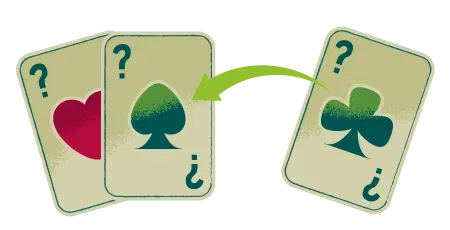 As I mentioned above, sometimes one or the other hand will require a third card. The third card draw rules often confuse players, which is another reason they shy away from playing Baccarat. Listen up:Baccarat is not like blackjack where you have to memorize a bunch of rules to know when to stand or hit. Nope, because when you play Baccarat, players have no playing options. There are standard house rules that determine when the Player Hand needs a third card and ditto for the Bank Hand. Moreover, it’s up to the Caller to determine which hand requires a third card. However, you will enjoy the game better if you have some familiarity of the third card draw rules, which I’m about to cover.
As I mentioned above, sometimes one or the other hand will require a third card. The third card draw rules often confuse players, which is another reason they shy away from playing Baccarat. Listen up:Baccarat is not like blackjack where you have to memorize a bunch of rules to know when to stand or hit. Nope, because when you play Baccarat, players have no playing options. There are standard house rules that determine when the Player Hand needs a third card and ditto for the Bank Hand. Moreover, it’s up to the Caller to determine which hand requires a third card. However, you will enjoy the game better if you have some familiarity of the third card draw rules, which I’m about to cover.
PLAYER HAND THIRD CARD RULE
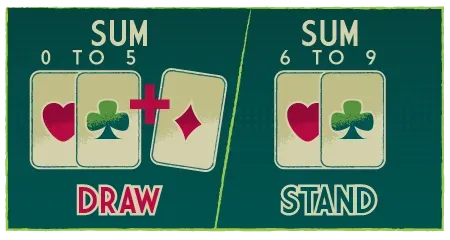 The criterion that determines if the Player Hand receives a third card is the total of the initial two cards.
The criterion that determines if the Player Hand receives a third card is the total of the initial two cards.
- Player hand draws a third card if the initial two cards total 0 to 5.
- Stands on a total of 6 through 9.
Notice that it makes no difference what the initial two-card Bank Hand totals or whether the Player hand is “beating” the Bank Hand as far as the third card draw rule. The rule is quite simple:
- If the sum of the two cards is 0 to 5, it draws a third card
- If the sum is 6, 7, 8, or 9, it automatically stands.
Now is a good time for me to explain what happens when the Player or Bank Hands initial two cards total 8 or 9. A total of 8 and 9 in Baccarat is known as a “natural” and when this occurs, neither hand can draw a third card. (A total of 9 is the highest total you can get in Baccarat, much like 21 in blackjack; the 8 is the second highest hand.)

Here are a few examples of Player Hands and whether they stand or draw:
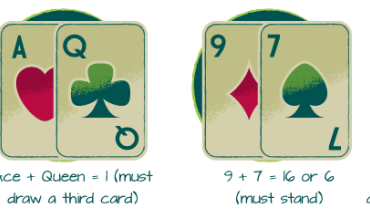
BANK HAND THIRD CARD RULE
The third card rule for the Bank Hand is slightly more complicated than the Player Hand. But keep this in mind … it’s not necessary to memorize the following rules if you don’t want to because the Caller is paid to know them and he will determine when it’s necessary that one or both hands should receive a third card.
The rule for the Bank Hand drawing a third card depends on three criteria:
- Total of the initial two card Bank Hand
- Whether the Player Hand stood or drew a third card
- What the value is of the Player Hand's third card
Here is a summary of the Bank Hand Third Card Rules:
Rule #1: Bank Hand draws if the initial two cards total is 0, 1 or 2.
Rule #2; Bank Hand stands if the initial two cards to either the bank or Player Hand total 8 or 9 (natural).
Rule #3. Bank Hand stands if the initial two cards total 7.
Rule #4. Bank Hand stands if the initial two cards total 6 and the Player Handdid not draw a third card. (if the Player Hand drew a third card, see rule 5.)
Rule #5: When the Bank Hand’s initial two cards total 3, 4, 5, and 6 and Player Hand draws a third card, the Bank Hand stands or draws as follows:
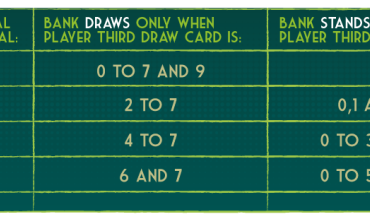
I’ve summarized the above Bank Hand draw rules in the following table (similar to a blackjack strategy table).
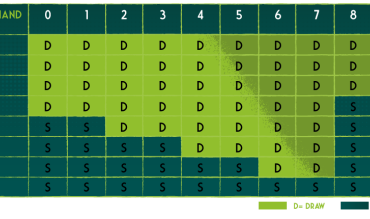
Let’s try a few sample hands so you get the hang of the rules for standing and drawing. The first column below is the Player Hand; the second column is the Bank Hand. The third column is the correct action based on the house rules.

Note: Keep in mind that even though it is not necessary to memorize the above third card rules, if a dealer makes a mistake you won’t know it. My suggestion is you should become familiar with the third card rules. The Player Hand is simple to remember; the Bank Hand is more complicated but you can always jot down the above Third Card Rules on paper and refer to them when you play. After playing awhile, you will quickly become familiar with the rules.
BTW: In the event, a dealer makes a mistake, be sure to bring it to her attention immediately before the cards are discarded, and ask for a casino supervisor to review the hand.
BACCARAT HOUSE EDGE
The math of Baccarat has been determined by numerous gambling mathematicians. Below is the bottom line. (Assumes an 8-deck game; 1 to 1 payoff for a winning bet, and in the case of the Bank Hand, a 5% commission; and an 8 to 1 payoff for the Tie bet).
- Bank Hand wins 45.87% of the hands, loses 44.63% of the hands, and ties 9.51%
- Player Hand wins 44.63% of the hands, loses 45.87%, and ties 9.51%
If you ignore, the hands that tie, then:
- Bank Hand wins 50.68% of the hands and loses 49.32% of the hands.
- Player Hand wins 49.32% of the hands and loses 50.68% of the hands.
Notice that when you exclude tied hands, the Bank Hand wins more often than it loses. To compensate for this, the casino charges a 5% commission on a winning Bank Hand. (With the 5% commission, the house advantage on the Bank Hand is close to the house advantage on the Player Hand. See below for house advantages.)
The House Edge for the Bank, Player and the Tie bet can be calculated by multiplying the probability that the hand will win by the amount wagered plus the probability of the hand losing times the amount lost (expressed as a negative value). The result is the player’s expected value per hand, which is the opposite of the house advantage.
PLAYER HAND HOUSE EDGE
(+1 unit) x (.4463 probability of winning) plus (–1 unit) x (.4587 probability of losing) plus (0 units) x (0.0951 probability of tie) = –0.01235.
(This means a player would have a –1.24% expected value, or the house advantage is 1.24%.)
BANKER HAND HOUSE EDGE
(+0.95) x (.4585) plus (–1) x (.4462) plus (0) x (.0951) = –0.01058 or a house advantage of 1.06%.
TIE BET
(+8 units) x (0.09516) plus (–1) x (.4585) plus (-1) x (.4462) = –0.14356 or house edge of 14.36%.
If you ignore the 9.51% of the hands that result in a tie, the house advantage for the Player and Bank Hand per resolved bet can be expressed as follows:
PLAYER HAND: 1.36%
BANK HAND: 1.17%
SUMMARY OF HOUSE ADVANTAGE
 Note: A house advantage of 1.36% on the Player Hand (excluding hands that tie) means that for every $100 worth of resolved bets that you make on the Player Hand, your expected loss is $1.36. You could get lucky and win money or lose more than $1.36, but over time you can expect to lose $1.36 for every $100 worth of resolved bets on the Player Hand. Betting on the Bank Hand will cost you slightly less money: ($1.17 per $100 wagered). (See Chapter 3 for further discussion on betting strategies for Baccarat.)
Note: A house advantage of 1.36% on the Player Hand (excluding hands that tie) means that for every $100 worth of resolved bets that you make on the Player Hand, your expected loss is $1.36. You could get lucky and win money or lose more than $1.36, but over time you can expect to lose $1.36 for every $100 worth of resolved bets on the Player Hand. Betting on the Bank Hand will cost you slightly less money: ($1.17 per $100 wagered). (See Chapter 3 for further discussion on betting strategies for Baccarat.)
Whether you express the house edge per hand (including ties) or per resolved bet (excluding ties), the expected player losses will be the same.
The following is true about Baccarat:
- Bank hand has a slightly lower house edge than the Player Hand
- The tie bet has an outrageous 14.36% house edge and should be avoided
REDUCED COMMISSION ON BANK HAND
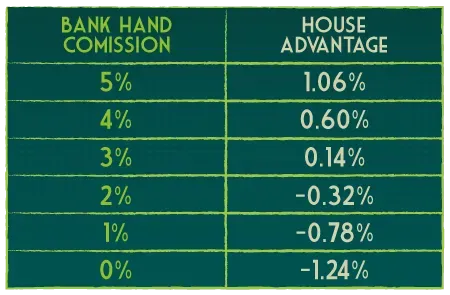 In the past, some casinos have reduced the commission on the Bank Hand to less than 5%. I once took advantage of a 4% commission on winning Bank Hand bets at Binion’s Horseshoe casino in downtown Las Vegas. There have been other casinos (land-based and online) that have offered a lower commission. This is a good deal for players. The following table shows how much you can lower the house edge on the Bank Hand based on the commission charged. (From the book Gambling 102 by Michael Shackleford). (Note: A negative house advantage indicates a player advantage. A player gains the advantage when the commission is reduced to 2% or lower.
In the past, some casinos have reduced the commission on the Bank Hand to less than 5%. I once took advantage of a 4% commission on winning Bank Hand bets at Binion’s Horseshoe casino in downtown Las Vegas. There have been other casinos (land-based and online) that have offered a lower commission. This is a good deal for players. The following table shows how much you can lower the house edge on the Bank Hand based on the commission charged. (From the book Gambling 102 by Michael Shackleford). (Note: A negative house advantage indicates a player advantage. A player gains the advantage when the commission is reduced to 2% or lower.
Bottom Line: If you ever learn of a land-based or online casino that has a lower than 5% commission on a winning Bank Hand, take advantage of it before it becomes history.
KEY TAKEAWAYS
- Baccarat is based on the Italian game of baccara, which means zero
- There are only three bets that you can make when you play baccarat. A bet on the Bank Hand, the Player Hand, or the Tie
- Objective of the game is to guess which hand (Bank or Player) is closest to 9.
- There are three different sized baccarat tables: mini-baccarat, midi-baccarat, and the full size (or big) Baccarat table.
- Mini-Baccarat tables are located in the main casino and have low stakes, players do not handle the cards, and the table can accommodate up to 6-7 players.
- Up to nine players can play Midi-Baccarat; stakes are usually higher than at Mini-Baccarat, and players can handle the cards
- The full-size (or big) Baccarat table is located in the high-roller pit; up to 14 players can play, the stakes are very high, and players can handle the cards.
- Winning Player Hand bets pay 1 to 1.
- Winning Bank Hand bets pay 1 to 1 but you must pay a 5% commission (resulting in a 19 to 20 payout). · Winning Tie bet pays 8 to 1
- Card values .are: 2s through 9s count face value, tens and picture cards count zero, and the ace counts 1.
- Two cards are initially dealt to the Player and Bank Hands. There are house rules that determine whether the Player or Bank Hand requires a third card.
- If the total of a hand exceeds 9, drop the first digit of the total, or subtract 10 from the total, to get the adjusted count of the hand.
- Excluding ties, the Bank Hand wins more times than it loses.
- Including ties, the house edge on the Bank Hand is 1.06%; on the Player Hand it is 1.24%; and for the Tie it’s 14.36%.
- Baccarat’s overall house advantage is about 1.2%, which is one of the lowest in the casino.
- If the commission on a winning Bank Hand is reduced below 5%, the house edge decreases.
- Because the drawing rules are fixed, there is no opportunity for strategic decisions (like in the game of blackjack).
